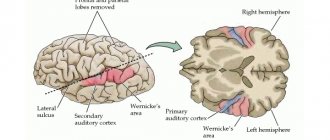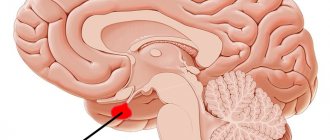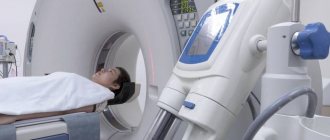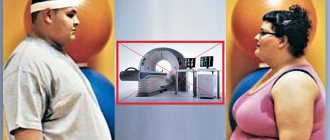MRI can be performed without a doctor's prescription
This is true.
The MRI machine does not have a harmful effect on human health, so the patient can apply for an MRI study himself if something bothers him, but he has not received a referral for the study from a doctor.
However, it is worth thinking about what is the point of conducting this research? To make a correct diagnosis, you need to accurately determine the area of study. For example, pain in the legs occurs for various reasons: diseases of the lumbar spine, hip joints, blood vessels, or diabetes mellitus.
Only the attending physician can determine the type and area of research after a careful examination and thorough analysis of the patient’s complaints. Without a doctor's direction, the patient may make a mistake and do the wrong test.
Before coming for a test without a doctor’s referral, we recommend weighing the pros and cons.
Pros:
- Most likely, nothing will be found out about you, and you will be able to calmly enjoy your life further.
- You will receive a research result that may be useful. If health problems arise in the future, taking pictures in a state of relative health will help doctors more accurately and quickly diagnose and prescribe treatment. Doctors will have the opportunity to compare images and track the dynamics of changes. For example, there are congenital characteristics that cannot always be accurately distinguished from diseases the first time. And if a doctor sees the same thing in a picture taken 10 years ago, then most likely these are not pathological changes, but congenital features.
- In very rare cases, the patient's concern is confirmed, and during the examination, serious diseases are found that require treatment.
Minuses:
- Most often, patients’ concerns are unfounded, and performing an MRI without a doctor’s referral makes no sense.
- Minor changes may be detected that are not clinically significant. But the very fact of their presence negatively affects the mood and sometimes the psyche of the patient. Instead of enjoying life, the patient falls into hypochondria, starts visiting all the doctors and taking unnecessary medications.
If you have a headache, you should definitely do an MRI of the brain.
Most often, patients who are bothered by headaches come for MRI of the brain. But in 80% of cases it is a tension headache associated with stress, fatigue, neck muscle tension, scalp tension, etc. None of this can be seen on an MRI. Such patients turn out to be healthy from an organic point of view: they have no changes in the substance of the brain. And their headaches should be treated by neurologists and cephalologists. Using MRI, you can exclude possible tumors, strokes, developmental features, anomalies, etc., but finding and treating the cause of the headache is the task of other specialists.
Newspaper "Rech" Issue dated May 28, 2021
Myths about MRI examinations portray this procedure as a horror story: the patient enters a huge and noisy machine, lies there in the dark and receives a lethal dose of radiation. Radiologist Tamara Leontyeva helped Rech with the rumors about MRI.
Why are people afraid of MRIs?
Fear of undergoing an MRI examination is not such a rare thing in the practice of doctors. Most often it is associated with fear of the medical office in general and fear of high-tech equipment.
But all modern magnetic resonance machines are as comfortable and safe as possible for patients. MRI is one of the safest research methods. Unlike radiography and computed tomography, it is not accompanied by ionizing radiation. Exposure to a magnetic field does not harm humans.
Medical contraindications for MRI may include panic attacks and claustrophobia (fear of closed spaces). But if the examination is vital for the patient, then there are ways to overcome them.
What are the benefits of MRI?
Since MRI does not contain harmful x-rays, the examination can be performed on children and pregnant women. Unlike CT scanning, breastfeeding mothers do not need to take a break from feeding after the procedure.
Due to the absence of radiation exposure, MRI can be used repeatedly to dynamically monitor the health status of patients and evaluate the effectiveness of treatment.
For whom is MRI contraindicated?
MRI is not done if the patient has: a pacemaker; metal implants (made of metal with ferromagnetic properties); intravascular stents; electronic inner ear implants; insulin pump; metal fragments and foreign bodies; permanent makeup and tattoos applied with dyes containing iron; congestive heart failure; renal failure; claustrophobia; mental illness.
Five myths about MRI
Tamara Leontyeva, head of the radiology department No. 1 of the Severstal medical unit, refuted five common myths about the MRI procedure.
Myth #1: You can't move during an MRI session. The study itself consists of several program cycles; if a person moves during this time, a high-quality image will not be obtained. But there are intervals between cycles when a little movement is permissible. In case of need to interrupt the examination, the patient has a signal bulb in his hands, which must be given out during the procedure to communicate with the x-ray laboratory assistant.
Myth No. 2: The doctor is behind a glass partition during the examination to protect against harmful influences. The tomograph is located in a so-called Faraday cage for shielding from electromagnetic influences from the outside. And they are inevitable when operating computers and other electronics. In order for the MRI machine to work properly, it must be isolated from other areas of the clinic. During the study, the doctor constantly monitors the patient and can speak to him via speakerphone.
Myth #3: The results provide an immediate diagnosis. The study provides very accurate results. But instant diagnosis is not always possible. As a rule, images obtained with MRI complement the results of other studies, and only analysis of all data allows a correct diagnosis to be made.
Myth #4: Doctors can recognize the thoughts of patients undergoing an MRI examination. MRI of the head allows you to observe the activation of certain centers in the brain, but this does not provide insight into the thoughts of patients. Yes, experiments are being conducted around the world on using MRI to detect lies. But these are just attempts. Thoughts are a biochemical-electrical process, and no one can “see” them.
Myth #5: MRI cannot be done with dentures. Modern metal structures are in most cases made from MRI-safe materials. Examinations can be performed with dental implants and braces, however, if an MRI of the brain is required, a consultation with a radiologist is necessary. Pins and structures that fasten bones in the oral cavity will not interfere with the study if the operation was performed after 2006 - since this year, non-magnetic metal structures have been used in the Russian Federation and developed countries.
Zhanna Gazzaeva
An MRI machine is a confined space
Typically, patients are worried before the test because they are afraid of being in a confined space. In fact, an MRI machine is a kind of pipe where there is air, fans, lighting and communication with a doctor. Once the patient is there, he realizes that he is in an open space and his fear disappears.
There are certain groups of people, for example, combatants, with whose claustrophobia nothing can be done. For such patients, we offer another imaging method: computed tomography or open tomography.
How to calm down before an MRI?
An MRI examination is a completely painless procedure, but the noise of its coils can frighten a patient who is encountering such equipment for the first time. To drown out noise, a good clinic will always offer the patient earplugs or headphones. Some patients who completed the study did not consider the noise of the CT scanner to be something that could be frightening, and compared its sounds to the noise made by a washing machine.
You should also not scare yourself that if suddenly “something goes wrong,” the x-ray technician and the doctor will not have time to react. Remember that at any time you can press a special button, and a laboratory assistant will immediately come to you. In addition, during the examination you will always be under the supervision of medical personnel who monitor the process through glass.
Not sure if you should take sedatives before the test or if you can have an MRI if you are claustrophobic? Read the answers to these questions in our second article, “MRI: is it scary to do it?”
MRI is harmful to health
The operating principle of the device is based on magnetic fields, and the research process is safe from the point of view of ionizing radiation - it is absent . There is simply no harmful radiation. Unpleasant sensations during the examination are caused by the need to lie still, sometimes for quite a long time. But for the sake of your health, it’s worth being patient, because MRI is one of the most informative methods for studying and diagnosing diseases of the central nervous system, human musculoskeletal and joint systems, etc., which means it helps to make an accurate diagnosis and prescribe the correct treatment.
The contrast agent has many side effects
Sometimes, for research, patients are given an intravenous drug containing the metal gadolinium. It helps to better visualize certain structures; by the accumulation of this drug in tissues, you can track the presence of tumors, their prevalence, etc. This drug is much safer than the one used in computed tomography. The risk of an allergic reaction is minimal.
The contrast agent, like all medications, has possible side effects, but in general it is hypoallergenic, well tolerated by patients, and most importantly, it increases the accuracy of diagnosis.
The administration of such a drug may be contraindicated only in patients with renal failure, who must notify the doctor about their disease. In such cases, the patient will first have to take a blood test, based on the results of which a decision will be made on whether to administer the drug.
The presence of any metal implants is a contraindication for MRI
The only absolute contraindication to MRI is the presence of a pacemaker or cochlear implant. The presence in the patient's body of metal prostheses and implants, plates, surgical staples, vena cava filters, stents, dental pins, braces and other metal objects is not a contraindication to MRI.
Conducting research is possible. Difficulties may arise with visualizing tissues and organs around a metal object, but this does not pose a danger to the life and health of the patient. It is necessary to inform the doctor about the presence of metal in the body, but conducting a study is most likely possible.
Risks and contraindications for MRI of the brain
Any medical procedure has both indications and prohibitions. There are two lists of contraindications for the use of brain MRI, divided into absolute and conditional. If there are conditional prohibitions, it is implied that the procedure can be carried out subject to additional preparation and accompanying manipulations. Absolute contraindications completely prohibit the use of MRI as a diagnostic measure.
Absolute contraindications for diagnosis:
- The presence in the body of implanted metal elements of foreign origin. The first point includes any implants, prostheses or metal-based devices. Magnet and metal interact strongly with each other. In a zone of a powerful magnetic field, such elements become very hot, attracted, deformed and displaced from their original position. During diagnosis, critical injury to the patient may occur. The device is also exposed to metal, the research results are greatly distorted, and the machine itself simply breaks down. We should not forget about non-removable electronic devices located on or inside the patient's body. They stop functioning and break down. The presence of such details must be reported to both the attending physician and the radiologist on duty at the clinic where you plan to undergo the scan. Otherwise, there is a risk of harming both yourself and the medical equipment.
- Early pregnancy (first trimester). It was previously said that MRI examination is so safe that it is recommended even for pregnant women. This is true, but in the initial stages there is an active formation of all the internal organs of the unborn child. Since medical practice has never conducted full-scale clinical studies on the influence of high-frequency magnetic fields on the intrauterine fetus during its active formation, doctors are trying to completely eliminate any external factors that could harm the unborn baby. From the fourth month of pregnancy, the ban is completely lifted, scanning can be done as many times as you like.
- Immune rejection to medications in case of planned contrast. The only risk when introducing a coloring substance is the manifestation of a severe allergic reaction, including anaphylactic shock. A small number of patients have individual intolerance to the components of the coloring solution. To prevent a reaction, skin testing for the effect of the drug is carried out in advance through microinjection. If a person experiences itching and redness at the injection site, contrast is not performed.
- Chronic urinary dysfunction with kidney damage. The prohibition also applies to contrast mode. In the normal version, the coloring drug is excreted naturally within 1-2 days after the session with urine flow. If the patient has poorly functioning kidneys, the drug is retained in the body for a long time, which leads to subsequent intoxication.
Relative contraindications to the procedure:
- Children's age (up to seven years). A feature of the mental development of children is the inability to control their motor activity for a long time. Added to this is the worry and anxiety of being in an unfamiliar environment, the absence of parents and loved ones at the time of screening, and fear. A guarantee of obtaining high-quality images is to remain completely still during an MRI; children cannot maintain a static position for a long time. The only way out is to use light sedatives or short-acting general anesthesia.
- Mental and neurological disorders. With these pathologies, a person is also unable to control his own involuntary movements. If it is necessary to conduct a study using hardware, anesthesia or sedatives are used in the same way.
- Claustrophobia. With uncontrolled fear of a closed room, which is also a capsule of a hardware installation with solid walls, the patient can go into a serious mental state. One of the options for getting rid of fear is turning to open configuration machines. They do not have solid walls, but are represented by separate ring parts or a small room, in which the magnetic field is generated from the outside. A person can breathe freely and see what is happening around him, which does not provoke attacks of panic.
- Excess body weight exceeding 120-200 kg. Closed configuration tomographs are manufactured according to specified standards. It is impossible for obese people to fully fit inside such installations. Open tomographs, which have no weight restrictions, come to the rescue.









